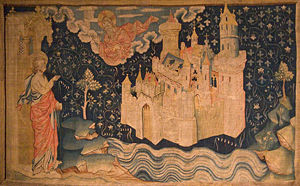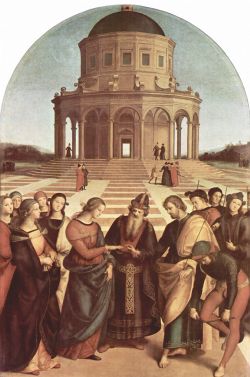Difference between revisions of "Bride of Christ" - New World Encyclopedia
m |
|||
| Line 1: | Line 1: | ||
{{Started}}{{Contracted}} | {{Started}}{{Contracted}} | ||
| − | [[Image:Boselli sposalizio S-Caterina.jpg|thumb|300px| | + | [[Image:Boselli sposalizio S-Caterina.jpg|thumb|300px|<p>The Mystical Marriage of St. Catherine</p> Antonio Boselli (Italy fl. 1496-1536)]] |
[[Image:La nouvelle Jérusalem.jpg|thumb|300px|"I saw the Holy City, the new Jerusalem, coming down out of heaven from God, prepared as a bride beautifully dressed for her husband." (Revelation 21:2)]] | [[Image:La nouvelle Jérusalem.jpg|thumb|300px|"I saw the Holy City, the new Jerusalem, coming down out of heaven from God, prepared as a bride beautifully dressed for her husband." (Revelation 21:2)]] | ||
| Line 6: | Line 6: | ||
Literally, the most common expression is to be found in believers who report a "mystical union" with [[ Jesus Christ]]. The idea of a literal, physical bride of Jesus on earth during the period of his ministry (or [[Incarantion]])is however, considered an unthinkable [[heresy]] within most all [[Christianity|Christendom]]. However, the suggestion of such an idea has persisted and has recently been revived, particularly through contemporary interpretations of the legend of the [[Holy Grail]]. | Literally, the most common expression is to be found in believers who report a "mystical union" with [[ Jesus Christ]]. The idea of a literal, physical bride of Jesus on earth during the period of his ministry (or [[Incarantion]])is however, considered an unthinkable [[heresy]] within most all [[Christianity|Christendom]]. However, the suggestion of such an idea has persisted and has recently been revived, particularly through contemporary interpretations of the legend of the [[Holy Grail]]. | ||
| − | Metaphorically, the ''Bride of Christ'' is a term most often representing the body of believers of the Christian [[Church]] or the ''[[Ecclesia]]''.<ref> | + | Metaphorically, the ''Bride of Christ'' is a term most often representing the body of believers of the Christian [[Church]] or the ''[[Ecclesia]]''.<ref>[http://www.biblegateway.com/passage/?search=ephesians%205:22-5:33&version=9 Ephesians 5:22-23]</ref> The reference originates from the Old Testament prophets who described [[Children of Israel|Israel]] as God's bride.<ref>{{cite web |work=Bible, see also Hosea, Ezekiel and the Song of Solomon |url=http://www.biblegateway.com/passage/?search=Isaiah%2054:%205; |title=Isaiah 54:9 }}</ref> |
In the Catholic church, this image of the Church as Christ's bride has been connected or associated with [[nun]]s and consecrated virgins.<ref>{{cite web | title=Consecrated virgins and widows | url=http://www.usccb.org/catechism/text/pt1sect2chpt3art9p4.htm#922 | work=[[Catechism of the Catholic Church]] }}</ref> For some women, the image describes a more personal, mystical relationship with Jesus. Several examples include [[Anne Catherine Emmerich]], [[Joanna Southcott]], [[Gertrude Morgan]], [[Åsa Waldau]], [[Catherine of Alexandria]], [[Catherine of Siena]], and [[Catherine de' Ricci]]. | In the Catholic church, this image of the Church as Christ's bride has been connected or associated with [[nun]]s and consecrated virgins.<ref>{{cite web | title=Consecrated virgins and widows | url=http://www.usccb.org/catechism/text/pt1sect2chpt3art9p4.htm#922 | work=[[Catechism of the Catholic Church]] }}</ref> For some women, the image describes a more personal, mystical relationship with Jesus. Several examples include [[Anne Catherine Emmerich]], [[Joanna Southcott]], [[Gertrude Morgan]], [[Åsa Waldau]], [[Catherine of Alexandria]], [[Catherine of Siena]], and [[Catherine de' Ricci]]. | ||
| Line 16: | Line 16: | ||
[[Image:Raffael 098.jpg|thumb|250px|Marriage of the Virgin (Raphael) (1504)]] | [[Image:Raffael 098.jpg|thumb|250px|Marriage of the Virgin (Raphael) (1504)]] | ||
| − | |||
==Notes== | ==Notes== | ||
Revision as of 02:56, 18 November 2007
The Mystical Marriage of St. Catherine
Antonio Boselli (Italy fl. 1496-1536)The term Bride of Christ can be found in Torah, the Old Testament and in the New Testament. It has long been debated and interpreted withinJudeo-Christian circles as both a literal and metaphorical reference. Literally, the most common expression is to be found in believers who report a "mystical union" with Jesus Christ. The idea of a literal, physical bride of Jesus on earth during the period of his ministry (or Incarantion)is however, considered an unthinkable heresy within most all Christendom. However, the suggestion of such an idea has persisted and has recently been revived, particularly through contemporary interpretations of the legend of the Holy Grail.
Metaphorically, the Bride of Christ is a term most often representing the body of believers of the Christian Church or the Ecclesia.[1] The reference originates from the Old Testament prophets who described Israel as God's bride.[2]
In the Catholic church, this image of the Church as Christ's bride has been connected or associated with nuns and consecrated virgins.[3] For some women, the image describes a more personal, mystical relationship with Jesus. Several examples include Anne Catherine Emmerich, Joanna Southcott, Gertrude Morgan, Åsa Waldau, Catherine of Alexandria, Catherine of Siena, and Catherine de' Ricci.
The Church as the Bride
Mystical Marriage
Notes
- ↑ Ephesians 5:22-23
- ↑ Isaiah 54:9. Bible, see also Hosea, Ezekiel and the Song of Solomon.
- ↑ Consecrated virgins and widows. Catechism of the Catholic Church.
ReferencesISBN links support NWE through referral fees
- Hanson, Dr. Sharon. The Marriage of the Bride of Christ. Lulu Enterprises, UK Ltd (November 7, 2006). ISBN 978-1847287885.
- Inglis, Cecilia. Cecilia: Bride of Christ & Beyond. Penguin Global (February 15, 2004). ISBN 978-0143001294.
- Ingram, John. Beyond Da Vinci: The True Bride of Christ. AuthorHouse (July 20, 2006). ISBN 978-1425945091.
- Johnston, William. Mystical Theology: The Science of Love. Orbis Books (March 1998). ISBN 978-1570751752.
- Lawley, Martha. Attending the Bride of Christ. Lifeway Church Resources (2005). ISBN 978-1415820919.
External Links
- What does it mean that the church is the bride of Christ? GotQuestions.org.
- The Bride of Christ : a problematic wedding - Ephesians 5:22-33 Biblical Theology Bulletin, Spring, 2002 by Carolyn Osiek.
- The Bride of Christ: Is the Church really Christ's bride? SeekersTrove.com - Where the Bible is King.
- The Bride of Christ by Pastor Jim Feeney, Ph.D.
- Who Is The Bride of Christ? Chapter 14; by Eddie Chumney; Hebraic Heritage Ministries International.
- The Bride of Christ by Paul Carus; The Open Court Publishing Co. (1907).
- The Bride of Christ Grace Points.com.
- The Legend of Saint Catherine of Alexandria
- Catherine of Alexandria article on Orthodox Wiki.
- Saint Catherine of Siena
- St. Catherine de' Ricci
Credits
New World Encyclopedia writers and editors rewrote and completed the Wikipedia article in accordance with New World Encyclopedia standards. This article abides by terms of the Creative Commons CC-by-sa 3.0 License (CC-by-sa), which may be used and disseminated with proper attribution. Credit is due under the terms of this license that can reference both the New World Encyclopedia contributors and the selfless volunteer contributors of the Wikimedia Foundation. To cite this article click here for a list of acceptable citing formats.The history of earlier contributions by wikipedians is accessible to researchers here:
The history of this article since it was imported to New World Encyclopedia:
Note: Some restrictions may apply to use of individual images which are separately licensed.

